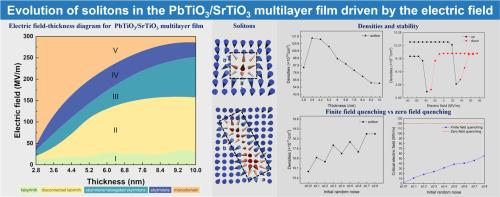Evolution of solitons in the PbTiO3/SrTiO3 multilayer film driven by the electric field
IF 8.3
1区 材料科学
Q1 MATERIALS SCIENCE, MULTIDISCIPLINARY
引用次数: 0
Abstract
Polar topologies constitute of a great platform for designing and developing new high-density electronic memories. Exploring their evolutionary processes with the applied electric field is of great significance to understand and regulate novel topological domain structures. Here, phase field simulations were used to study the evolution processes of the PbTiO3/SrTiO3 multilayer film with different thicknesses under the applied electric field. The electric field-thickness phase diagram of the multilayer film was constructed, paying special attention to the electric field range of the solitons, as well as their densities during the application of the electric field in multilayer film of different thicknesses. When the electric field is withdrawn, the density of solitons remains constant, manifesting the non-volatility or topological protection of these topological structures. The phase diagram for zero-electric-field solitons reveals that these solitons can persist over a significantly broader electric field range. Quenching under the finite external field, skyrmions can be obtained at a lower electric field. These results may have guiding significance for designing and developing next-generation nanoelectronic devices based on topological structures.


求助全文
约1分钟内获得全文
求助全文
来源期刊

Acta Materialia
工程技术-材料科学:综合
CiteScore
16.10
自引率
8.50%
发文量
801
审稿时长
53 days
期刊介绍:
Acta Materialia serves as a platform for publishing full-length, original papers and commissioned overviews that contribute to a profound understanding of the correlation between the processing, structure, and properties of inorganic materials. The journal seeks papers with high impact potential or those that significantly propel the field forward. The scope includes the atomic and molecular arrangements, chemical and electronic structures, and microstructure of materials, focusing on their mechanical or functional behavior across all length scales, including nanostructures.
 求助内容:
求助内容: 应助结果提醒方式:
应助结果提醒方式:


